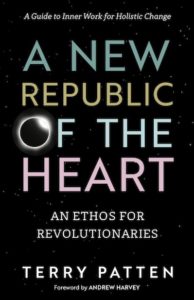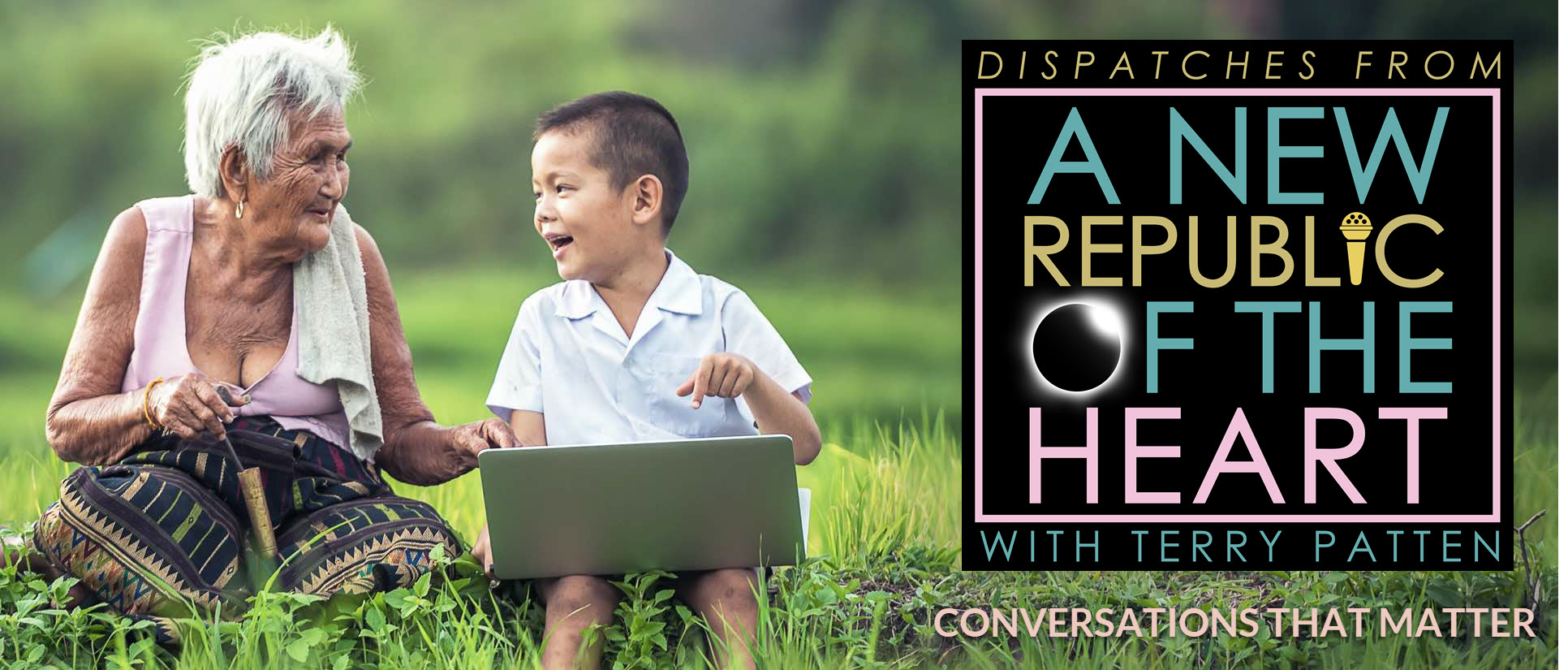Have a listen»
Posts in the Quote Series
0: Introduction: What’s Really Happening
2.1 Gratitude, Grief, Good and Evil
2.2 Activism - The Highest Calling of our Character
4.1 More Than Darwin's The Origin of Species
4.2 Bending the Arc of Evolution
5.1 The Integral Perspective: Altitudes and Attitudes
5.2 Understanding our Multidimensional Reality through the Four Quadrants
Setting the Context
In the first segment of Chapter Two, Terry Patten asserts that activists not only need to have the will to right the world’s wrongs, they also need to be prepared to confront the doers of those wrongs with one hand tied behind their backs. These wrongdoers usually have the overwhelming advantage of money and all it can buy, and are prepared to use it aggressively to keep things just as they are.
Against those odds, activists, the political and social change makers of our day, lose far more struggles than they win. What continually drives them to embark on their “fool’s errand”? Patten takes us to the heart of this question in the second half of Chapter Two in his book, A New Republic of the Heart; An Ethos for Revolutionaries.
We are the Voices Blog team of the New Republic of the Heart community, reading our favorite excerpts from Chapter Two, Translating Heartbreak into Action – Part 2.
Selected Readings From A New Republic of the Heart
Recitations by Anneke Edson, David Chasteen, Sallie Justice, Phil Justice, and Ed Prell
Chapter 2: Translating Heartbreak into Action – Part Two
THE HIGHEST CALLING OF OUR CHARACTER
(p. 56) It is worth considering three individuals particularly: Mahatma Gandhi, Martin Luther King, Jr., and Nelson Mandela. Each of them catalyzed great societal shifts whose time had come. These leaders were able to rise above and harmonize the negativity, reactivity, and conflict that tended to compromise others.
(p. 56) They helped reweave the social fabric. They did this in part by their words and deeds and ideas and policies. But they especially led by their example. These three iconic figures are almost universally acknowledged as “saints with cojones,” world-transforming servant-leaders, the exemplars of the highest potential of leadership and greatness.
(p. 56) Gandhi and King in particular were career-long advocates of nonviolent resistance, a strategy that can not only be extraordinarily effective, but can actually transform one’s adversaries—or weaken them, but based on the adversaries’ own responses. On a large scale, Gandhi’s activities eventually led to Indian independence from Britain.
(p. 56) Psychologist and educator Howard Gardner saw Gandhi as a particularly outstanding exemplar of a class of individuals he refers to as “influencers.” “All assumed that the struggle would eventually have to be engaged violently—with English arms and prestige being arrayed against Indian numbers and nationalistic zeal. Gandhi succeeded in convincing people the world over to reconceptualize matters”—including judging people as fellow human beings and keeping disagreements nonviolent. But, “most stirringly, both parties in a conflict can be strengthened if they handle themselves with dignity in the course of nonviolent confrontations.”
(p. 57) Activists have an irreplaceable cultural role, helping societies to evolve. It is undeniable that societies transform through many diverse processes. But historically, many of our most important transformations, the key historical advances, have required struggle. In order for history to proceed, people have had to advocate for the new. They have had to criticize old, outmoded customs and policies, recognize the next possibility, speak up, join together, act upon that recognition, and exert influence. Activists have moved history forward.
THE SOUL OF ACTIVISM
(p. 58) We become activists after we notice suffering and destruction, cruelty and indifference, waste and peril, and the harm in which we are living–and heed the biblical injunction to “not stand idly by.”
(p. 58) When we see such injustice, we feel absolutely compelled to act. We speak up. We listen to the stories of others who have been through similar experiences, or whose own experiences inform us and rouse us to action. When a group of us agrees, and we dare to believe we can make a difference in some way, and we cooperate to make something happen, we have become activists.
(p. 58) It can be scary to defy the norm, to dare to attempt to exert influence. You must be willing to take risks. Sometimes they are just the “opportunity costs”of giving your energy to a cause instead of investing in yourself. Sometimes they are risks of ridicule, rejection, and retribution.
(p. 58) And sometimes they are big risks—risks of real losses to one’s job, career, community standing, and personal comfort. Sometimes there are even risks of imprisonment, violence, torture, death, or retribution against loved ones. Wherever we may be on the spectrum of activism, to become an activist takes courage.
(p. 58) Everyone who begins as an underdog, or as an ordinary individual who leads an ordinary life, and then becomes challenged or moved to stand for higher values on behalf of a community or principle, is expressing the heroic qualities of the activist.
(p. 58 & 59) Activism expresses fellowship, connection, relationship, a sense of brotherhood and sisterhood. Our connectedness in the service of larger things transcends the superficiality of many relationships and associations.
(p. 59) The soul of activism was captured by Pope Francis’s invocation, “Let us be ‘protectors’ of creation, protectors of God’s plan inscribed in nature, protectors of one another and of the environment.”
(p. 59) History is replete with horrible human suffering—from plagues to wars to holocausts to unspeakable cruelties against women, slaves, adulterers, gays, heretics, infidels, people of color (and those who consorted with them), aboriginals, foreigners, animals, and the natural environment.
(p. 59) And it is only because these horrors were witnessed and addressed by activists (humanitarians, prophets, saints, scientists, physicians, abolitionists, political dissidents) that even more unspeakable atrocities or more horrific scenarios were avoided. In a similar fashion, it will take activism to avoid or mitigate the worst-case scenarios that our own prophets—often our scientists—are warning against.
(p. 59) Middle-class citizens of imperfect Western democracies benefit from science and technology and rational discourse, privy to all the converging streams of human culture, including our highest wisdom traditions.
(p. 60) In these times, if we have the opportunity to live extraordinarily meaningful lives, I feel we have an obligation to do so. If the measure of a human life is its chance to have significance that extends beyond itself, then we’ve hit the jackpot. We are alive at game time on the planet, when everything that we value is genuinely threatened, when it’s time for all hands on deck.
THE SHADOW SIDE OF ACTIVISM
(p. 60) Meaningful service gives activists’ lives deep purpose and significance. And solidarity and fellowship can be gratifying and nurturing. And yet we also endure much frustration. Overall, the concerns that motivate activists have also tended to drain us. Any innovative social initiative must overcome tremendous inertia.
(p. 60) Institutional change tends to take place very slowly, with victories coming only after many years of very little apparent progress. And there is little funding for it, so activists often make personal sacrifices in service of a cause—and then we rarely see quick successes.
(p. 60) Activism requires enduring through difficulty. Activists take on an extra commitment. In addition to the need to survive and thrive personally, we are committed to making a difference at the level of society.
(p. 61) And we often find ourselves competing, at a disadvantage, with people who don’t take on these extra responsibilities.
(p. 61) It takes real wisdom and skill to keep our hearts open without letting the suffering in the world drain and deplete us. This is one of the most important capacities activists must build. We have to learn to put on our own oxygen mask first—silently, internally, many times a day.
(p. 61) The most basic level of the inner work is an absolute requirement: we must learn to manage our own emotions and motivations. If we develop the knack for caring for ourselves and allowing ourselves to be fed by the regenerative dynamics of our sincere care for the planet, the people, and the cause, we can learn to counteract the tendency to be depleted and drained by unproductive “overcare.”
(p. 61) Of course, that’s easier said than done. Many activists do get drained, and then live in stress, with a deep underlying sense of alarm, grief, or dread.
(p. 61) If the outer work is always prioritized over the inner work, personal needs go unmet. This inevitably undermines well-being and effectiveness, and often creates a subtle residue of resentment and righteousness.
(p. 61) Anger is very tricky—it’s a source of great power, but it can undermine everything it is trying to accomplish. Our job is to learn how to use the energy of that anger intelligently, so that we can thrive and create real change.
(p. 62) To the degree that our trauma has impaired us, it is imperative that we recover enough to end the cycle of injury and trauma. And that requires healing, new self-awareness, humility, and the courage to understand ourselves and engage life in positive terms. Then we can channel our energy in service of higher values, rather than recycling our unconscious compensatory motivations.
THE OUTER WORK IMPLIES THE INNER WORK
(p. 62) What will it take to co-create a new way of being human, and a new world? How do we get started? How do we transform what we are already doing (and how we are already being) so that we can actually achieve new results? Clearly we must move toward a convergence of the “inner work” and the “outer work.” This implies a life of practice and a truly integral revolution of the being.
(p. 62) We are awakening to new ways of seeing our work and the world. And we are awakening to new forms of outside-the-box thinking, with higher-order meta-perspectives on the issues facing our planet
(p. 63) Meanwhile, more and more spiritual practitioners are coming to recognize that our impulse toward awakening and self-actualization can be fulfilled only by being of real benefit to others.
As we awaken, a new kind of activist is awakening within us.
(p. 63) This is the “activism of awakening.” And we are beginning to see how such awakening—far from taking us away from the “on-the-ground” work—is actually a crucial dimension of even the most grounded initiatives focused on tangible benefits to systems, structures, people, and the planet.
Summary & Preview of What is Next
Historically, most revolutions fail and their adherents pay a terrible price. Three notable revolutions that did succeed; the American, the French, and the Russian revolutions toppled egregious regimes. Following their success, the French and the Russian uprisings failed when new tyrannies were swiftly imposed. In America, a democracy, although flawed, took hold and became a model for others to follow. America’s flaws continue to be challenged by courageous activists.
History confirms the points Terry makes in Chapter Two. It is not enough to recognize injustices, nor to desire change, nor to have a successful strategy to overcome them. This “outer work” of righting the wrongs needs to be powered by the “inner work” of self care and spiritual grounding that guides and sustains the activist beyond the finish line.
The looming worldwide crisis facing humanity is unprecedented, and demands that we get it right this time. Chapter Three will take a look at one key element of the inner work so vitally needed to guide our way.


